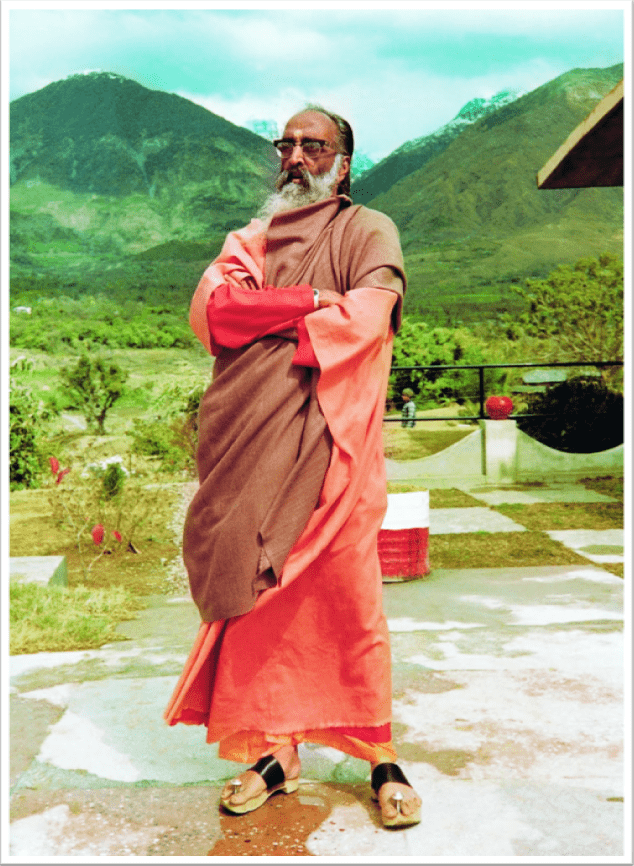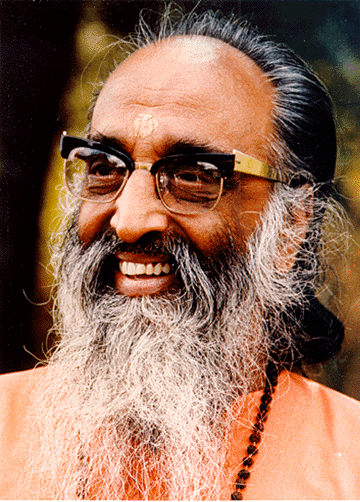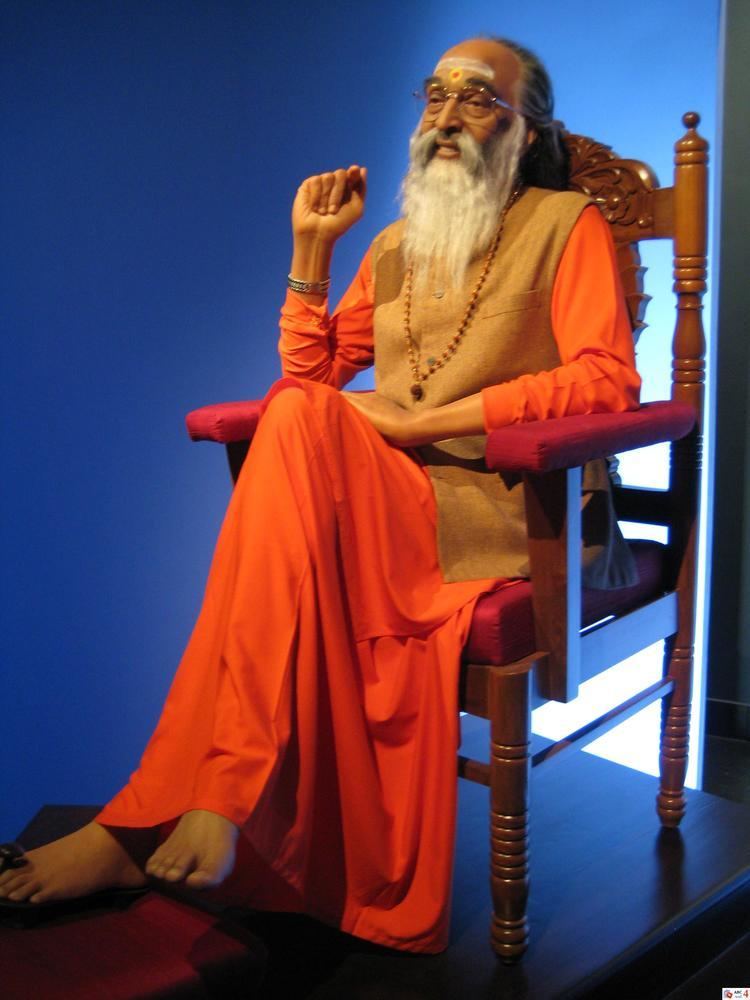Name Chinmayananda Saraswati | Role Spiritual leader | |
 | ||
Born Balakrishnan Menon8 May 1916Ernakulam, British India ( 1916-05-08 ) Founder of Chinmaya MissionVishva Hindu Parishad Literary works The Holy Gita and many more (See Bibliography) Quotation "The tragedy of human history is that there is decreasing happiness in the midst of increasing comforts.""The real guru is the pure intellect within; and the purified, deeply aspiring mind is the disciple.""We may often give without love, but we can never love without giving." Books Meditation and Life | ||
Similar Ranjit Maharaj, Nana Dharmadhikari , Dada Vaswani | ||
Greatness of swami chinmayananda saraswati prof shashi bhushan videsha vicharam 27 may 2015
Swami Chinmayananda Saraswati (born Balakrishna Menon; 8 May 1916 – 3 August 1993) was a Hindu spiritual leader and teacher who inspired the formation of Chinmaya Mission, a worldwide nonprofit organisation, to spread the knowledge of Advaita Vedanta, the non-dual system of thought found in the Upanishads, which epitomise the philosophical teachings of the Vedas.
Contents
- Greatness of swami chinmayananda saraswati prof shashi bhushan videsha vicharam 27 may 2015
- Pujya Swami Chinmayananda Saraswati
- Early life and education
- Indian independence movement and imprisonment
- Career in journalism
- Study of Vedanta
- Launch of spiritual movement
- Chinmaya Mission
- Vishva Hindu Parishad
- Passing Away
- Tribute
- Chinmaya International Foundation
- Nursery school
- Medical facilities
- Publications
- BMI chart
- Honours and recognition
- References

Chinmayananda is known for teaching Bhagavad Gita, the Upanishads, and other ancient Hindu scriptures. From 1951 onward, he spearheaded a global Hindu spiritual and cultural renaissance that popularised the religion's esoteric scriptural texts, teaching them in English all across India and abroad.

Chinmayananda inspired the formation of Chinmaya Mission in 1953. Founded by his disciples and led by him, it is a spiritual, educational, and charitable nonprofit organization that encompasses more than 300 centres in India and internationally. He authored 95 publications, including commentaries on the major Upanishads and Bhagavad Gita. He was a visiting professor of Indian philosophy at several American and Asian universities and he conducted university lecture tours in many countries.

Through his Vedantic teachings, publications, centres, ashrams, temples, and social service projects around the globe, his work continues to provide cultural and spiritual instruction to members of the Hindu diaspora. He died on 3 August 1993.

Pujya Swami Chinmayananda Saraswati
Early life and education

Balakrishna Menon, who later became known as Swami Chinmayananda, was born in the city of Ernakulam in present-day Kerala, India, on 8 May 1916, as the eldest son of a prominent judge, Vadakke Kuruppathu Kutta Menon, who was the nephew of the Maharaja of Cochin. His mother, Parukutty Amma died while giving birth to her third child.
He completed his formal schooling in Sree Rama Varma High School, Kochi (1921–1928) and Vivekodayam School, Thrissur (1928–1932). He completed his FA (Fellow of Arts) at the Maharaja's College, Ernakulam (1932–1934), and his BA (Bachelor of Arts) at the St. Thomas College, Trichur (1935–1937). He went on to Lucknow University (1940–1943) to earn postgraduate degrees in literature and law, while completing courses in journalism.
Although he would go on to become a celebrated spiritual teacher, in his student years, Balan had yet to formally accept religion. In the summer of 1936, he visited the eminent sage, Sri Ramana Maharshi. By Chinmayananda's later personal accounts, when Ramana Maharshi looked at him, he experienced a thrill of spiritual enlightenment which, at the time, he promptly rationalised away as being mere "hypnotism."
Indian independence movement and imprisonment
Approaching August 1942, in the midst of a wide-scale attempt by Indian activists to make the British "Quit India," Balan was one of the students to join in writing and distributing leaflets to stir up national pride. When word of a warrant for his arrest issued because of these activities reached him, he went undercover. He spent the next year moving around in the state of Abbottabad, out of range of British officials, and then moved toward Delhi.
Almost two years after the British had issued his arrest warrant, believing his case was long forgotten, Balan arrived in Punjab and associated himself with several freedom groups. He advised students on distributing leaflets and organising public strikes but was arrested and imprisoned. He spent several months in unhygienic conditions in prison and caught typhus. This caused him to be among those who were carried out into the night and tossed beside a road on the outskirts of the city, where he was found by a passing Indian Christian. Reminded of her son serving in the army, she took him to her home and called for a doctor, who insisted that he was taken to a hospital.
Career in journalism
Balan slowly recovered his health. K. Rama Rao gave Balan his first job, at The National Herald. He wrote a series of articles on the imperative of socialism in a society where the vast majority of people were poor. He covered subjects ranging from history and culture to social and political issues. Articles such as "In Praise of the Postman," and "The Mochi—Symbol of Craftsmanship," gained him a reputation as a controversial character. In 1947, he began a new series of articles for The Commonweal.
It was while working as a journalist that he wrote an article "exposing" sadhus. He travelled to Sivananda's ashram in Rishikesh for this purpose. He later said, "I went not to gain knowledge, but to find out how the swamis were keeping up the bluff among the masses."
Study of Vedanta
In the summer of 1947, Balan arrived in Rishikesh, by the banks of the Ganges and made the one-mile hike to the Divine Life Society, the ashram of Swami Sivananda. There he went from sceptic to enthusiast, finally becoming a renunciate monk. He began reading more about Hindu scriptures and reviewing spiritual books. Sivananda recognised Balan's latent talents and entrusted him to organise a Gita Committee. Having returned to the Divine Life Society ashram, on 25 February 1949, the holy day of Mahashivratri, Balan was initiated into sannyasa (Hindu vow of renunciation) by Sivananda, who gave him the name Swami Chinmayananda, or "bliss of pure Consciousness."
With Sivananda's blessing, Chinmayananda sought out one of the greatest Vedantic masters of his time, Tapovan Maharaj of Uttarkashi, and devoted the next few years of his life to an intensive study of Vedanta under his tutelage. As his disciple, from 1949, Chinmayananda led an extremely austere lifestyle and underwent a rigorous study of the scriptures. His day began at 3 a.m. with an icy bath in the Ganges and sometimes ended late in the night after hours of meditation by the river.
Launch of spiritual movement
In 1951, flying in the face of orthodox Hindu traditions but with the blessings of his guru, Chinmayananda decided to bring the teachings of Vedanta to the masses. It had been traditionally a knowledge reserved only for Brahmins. In May of that year, he left the Himalayas with a plan to set out on an all-India tour and to visit places of worship to see how Hindu religious heritage was being handed down. He said of that time: “I was miserably disillusioned and disappointed about ... the stuff doled out as the best in Hinduism. ... My experiences during those five months of roaming only strengthened my conviction that I must execute ... Upanishad Jñāna Yajña sessions (lecture series) all over India, in all the great cities."
Chinmayananda held his first lecture series at a Ganesha temple in the city of Pune in December 1951. His audiences soon swelled from a handful into thousands. Army officers from the Southern Command attended and the audience overflowed into the lanes near the temple. Brahmin priests were called to conduct the yajna (Vedic ritual), and to their surprise, everyone in the audience, man and woman, across all social strata, was asked to participate in the rituals.
Chinmaya Mission
At the end of the second jñāna yajña in Madras in 1953, a handful of people expressed the desire to create a forum for the study and discussion of Vedanta. Chinmayananda agreed in principle, but he said, "Don't start any organization in my name. I have not come here to be institutionalized. I have come here to give the message of our ancient sages, which has benefited me. If it has benefited you, pass it on."
The Madras group insisted that the best way to "pass it on" was through the support of a forum. They wrote back pointing out that the word "Chinmaya" did not have to indicate Chinmayananda's name, since, in Sanskrit, the world itself means "pure Knowledge," which they were seeking. He conceded. On 8 August 1953, the Chinmaya Mission was formed.
Before long, hundreds of study groups were set up all over the country for people to get together in small batches to study religion and philosophy in a systematic manner. Devi groups were organised for women to take up regular spiritual study and social work.
In 1956, the 23rd jñāna yajña in Delhi was inaugurated by the President of India, Rajendra Prasad. He spoke highly of the work Chinmayananda was doing to restore India's cultural glory. In a span of five years, Chinmayananda had instructed over 50,000 of his countrymen through 25 jñāna yajñas across the country.
On 6 March 1965, Chinmayananda set out on his first global teaching tour, covering 39 cities in 18 countries: Thailand, Hong Kong, Japan, Malaysia, United States, Mexico, Spain, United Kingdom, Belgium, the Netherlands, Sweden, Germany, Denmark, France, Switzerland, Italy, Greece and Lebanon. Over the next 28 years, he continued these international discourses, staying only a week or so in each place, delivering a minimum of two lectures a day, and handling numerous meetings, interviews, discussions, and programs. He wrote scores of letters a day.
It soon became necessary to co-ordinate the growing spiritual movement in the United States. Chinmaya Mission West was formed in 1975 for this purpose.
Chinmayananda's message resonated with heads of other faiths. One of his yajñas in Bombay was inaugurated by Cardinal Valerian Gracias, a prominent Catholic archbishop of the time. The Dalai Lama, head of the Tibetan Buddhist order, visited with him at the Chinmaya Mission ashram in Sidhbari in 1981. Chinmayananda was a supporter of interfaith dialogue and participated in many interfaith events.
In 1992, he undertook a lecture tour of twelve US universities to establish an international library and research center, the Chinmaya International Foundation, in Kerala, India.
Vishva Hindu Parishad
In 1963, Swami Chinmayananda wrote an article airing the idea of calling for a World Hindu Council, inviting delegates from throughout the world to discuss the difficulties and needs concerning the "survival and development of Hindu culture." This attracted the attention of RSS pracharak S. S. Apte, who was airing similar ideas at that time. Apte and Chinmayananda jointly organised such a conference at the Sandeepany ashram in August 1964, which resulted in the founding of the Vishva Hindu Parishad. Swami Chinmayananda was elected as President and Apte as general secretary of the new organisation.
Passing Away
Chinmayananda had chronic heart problems. He had his first heart attack in 1969, when his treatment at the newly opened Chinmaya Mission Hospital in Bangalore made him its first patient. In the summer of 1980, when he was in the United States for a series of jnana yajnas, he had to undergo multiple heart bypass surgery in Texas. On 26 July 1993, he suffered breathing problems in San Diego, California and on 29 July he had emergency heart bypass surgery at Sharp Memorial Hospital. His condition continued to be critical and he was put on a life-support system. He died on 3 August 1993. His followers mark the date as the occasion when he attained mahasamadhi.
On 7 August 1993, thousands of people were at Indira Gandhi International Airport in New Delhi when his body returned to India. It was transported to Sidhbari, Himachal Pradesh, where it was finally laid to rest in accordance with Vedic ritual. A mahasamadhi shrine has been built there.
Tribute
Forty years after his first jñāna yajña, on 24 December 1991, Chinmayananda's devotees gathered in Mumbai to offer him an amount of gold equal to his body weight, presented to him on a tula (ceremonial balance scale) in an age-old ritual called suvarņa tulābhāram. The funds generated were used to support the myriad service projects and programs of Chinmaya Mission.
Chinmaya Mission
Chinmayananda established ashrams around the world as places for spiritual retreat, study, and practice.
There are numerous and diverse devotional, spiritual, cultural, and social projects that the Chinmaya Mission continues to administer and conduct in Chinmayananda's memory, including the Bala Vihar, the Chinmaya Yuva Kendra (CHYK, the global youth wing of Chinmaya Mission), and Chinmaya Study Groups for adults, which are also known as Devi Groups. The Mission has also constructed over 58 temples in India and abroad and it operates the Chinmaya Organisation for Rural Development (CORD), which was founded by Chinmayananda to facilitate integrated sustainable development for the poor through self-empowerment.
Chinmaya International Foundation
He established the Chinmaya International Foundation at the Tharavad house of Adi Shankara which the foundation bought - in the village Veliyanad in Eranakulam District in Kerala.
Nursery school
From its beginnings in 1967 at a nursery school inaugurated by Chinmayananda in Kollengode, Kerala (India), today there are over 76 Chinmaya Vidyalayas (schools), seven Chinmaya colleges, and the Chinmaya International Residential School in India, and the first Chinmaya Vidyalaya outside India's borders, in Trinidad, West Indies.
Medical facilities
Chinmayananda inaugurated the Chinmaya Mission Hospital in 1970. The facility has grown into a modern, fully equipped 200-bed hospital in Bangalore in Karnataka, India.
In the late 1970s, Chinmayananda established rural health care services in Sidhbari, Himachal Pradesh, India.
Publications
Chinmayananda authored 95 publications in his lifetime, including forty commentaries on classical scriptural texts, eight compilations, 13 co-authored works and 34 original works. Over the years, luxury hotels in India started keeping a copy of his commentary on the Bhagavad-gita in all their guest rooms. His books, written in English, have been translated into numerous regional Indian languages, including Hindi, Tamil, Malayalam, Marathi, Telugu, Kannada, Odia, Bengali, Sindhi, and Urdu and in one European language, French. His birth centenary has been celebrated with publication of Chinmaya Birth Centenary Series. A series of 12 books are being published. The eleventh in the series is on Sadhana - the spiritual trail. The book is named as 'Life of I'
BMI chart
The BMI (Body Mind Intellect) Chart is a teaching tool innovated by Chinmayananda that became one of his hallmarks. It categorises the totality of human experience, according to the science of Vedanta, by drawing on 11 characters of the English and Devanagari alphabets.
Honours and recognition
On 2 December 1992, Chinmayananda addressed the United Nations and the talk was titled "Planet in Crisis."
The US magazine, Hinduism Today, conferred him with its Hindu Renaissance Award and the title of "Hindu of the Year" in 1992.
In 1993, he was selected as "President of Hindu Religion" for the Centennial Conference of the Parliament of the World's Religions in Chicago, where Swami Vivekananda had given his address one hundred years previously. He was also to be honoured for his selfless service to humanity in Washington, DC at "World Vision 2000," a conference of religious leaders organised by Vishva Hindu Parishad on 6–8 August 1993. He did not attend either of the latter two functions, as he died on 3 August 1993.
On 8 May 2015, Indian Prime Minister Narendra Modi released a commemorative coin to mark his birth centenary.
